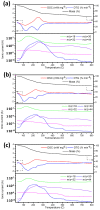New Composite Contrast Agents Based on Ln and Graphene Matrix for Multi-Energy Computed Tomography
- PMID: 36500733
- PMCID: PMC9737213
- DOI: 10.3390/nano12234110
New Composite Contrast Agents Based on Ln and Graphene Matrix for Multi-Energy Computed Tomography
Abstract
The subject of the current research study is aimed at the development of novel types of contrast agents (CAs) for multi-energy computed tomography (CT) based on Ln-graphene composites, which include Ln (Ln = La, Nd, and Gd) nanoparticles with a size of 2-3 nm, acting as key contrasting elements, and graphene nanoflakes (GNFs) acting as the matrix. The synthesis and surface modifications of the GNFs and the properties of the new CAs are presented herein. The samples have had their characteristics determined using X-ray photoelectron spectroscopy, X-Ray diffraction, transmission electron microscopy, thermogravimetric analysis, and Raman spectroscopy. Multi-energy CT images of the La-, Nd-, and Gd-based CAs demonstrating their visualization and discriminative properties, as well as the possibility of a quantitative analysis, are presented.
Keywords: X-ray; contrast agents (CAs); functionalization; graphene nanoflakes; lanthanide; multi-energy computed tomography; nanoparticle; photon-counting computed tomography; support.
Conflict of interest statement
The authors declare no conflict of interest.
Figures










References
-
- Ostadhossein F., Tripathi I., Benig L., LoBato D., Moghiseh M., Lowe C., Raja A., Butler A., Panta R., Anjomrouz M., et al. Multi-“Color” Delineation of Bone Microdamages Using Ligand-Directed Sub-5 Nm Hafnia Nanodots and Photon Counting CT Imaging. Adv. Funct. Mater. 2020;30:1904936. doi: 10.1002/adfm.201904936. - DOI
-
- Anderson N.G., Butler A.P., Scott N.J.A., Cook N.J., Butzer J.S., Schleich N., Firsching M., Grasset R., de Ruiter N., Campbell M., et al. Spectroscopic (Multi-Energy) CT Distinguishes Iodine and Barium Contrast Material in MICE. Eur. Radiol. 2010;20:2126–2134. doi: 10.1007/s00330-010-1768-9. - DOI - PubMed
Grants and funding
LinkOut - more resources
Full Text Sources

